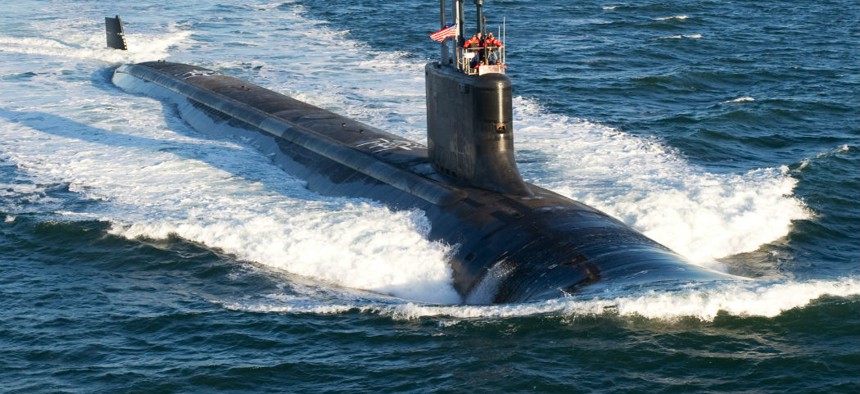Northrop Grumman Unveils New Sub Sonar
Northrop has introduced a next-generation flank array sonar designed to be more reliable than existing systems.
The Advanced Flank Array, or AFA, is an internal Northrop Grumman development project designed to meet U.S. Navy requirements for a next-generation flank array, which is sonar mounted on the sides of a submarine's hull.
The company recently demonstrated AFA for the Navy. "Recent testing conducted by the Naval Undersea Warfare Center for Northrop Grumman Corporation under a Work for Private Parties agreement demonstrated that the company’s new hull-mounted acoustic Advanced Flank Array (AFA) addresses next-generation flank array requirements," said a Northrop Grumman news release.
Northrop Grumman isn't touting better acoustic performance for AFA. Rather, the project aims to create a cheaper and more reliable sonar system. "Northrop Grumman’s Advanced Flank Array development was specifically focused on significantly improving manufacturing affordability and reliability while maintaining the Navy’s strict performance requirements for array technology," Northrop Grumman spokesman Charles Tragakis told Defense Systems.
Exactly what AFA will look isn't clear. But a clue might be found in the Light Weight Wide Aperture Array (LWWAA), which Northrop Grumman already manufactures for Virginia-class submarines. A 2016 company announcement described it as the only available fiber-optic passive hull mounted sensor array on the market. "The LWWAA system is a set of large array panels that are mounted on either side of the submarine which provide sonar sensor input to the submarine's combat system," according to Northrop Grumman's description. "Instead of traditional ceramic hydrophone sensors, the LWWAA uses FOAS [fiber-optic acoustic sensor] technologies to convert a target submarine's acoustic energy in the water into information that can be used to identify and track it."
In 2016, Northrop Grumman delivered the LWAAA shipset for Block IV Virginia-class submarines. Each shipset contains six sonar arrays. A Northrop Grumman illustration shows three arrays mounted on the side of a submarine, between the conning tower and the stern.
Northrop Grumman is banking on the company's previous work in providing flank arrays to the Navy. "Northrop Grumman’s proven track record in underwater acoustic systems production minimizes lifecycle system performance risk and positions them to be the low-risk prime contractor in support of next-generation flank arrays," notes a company news release. "The company’s open business model approach, which positions multiple vendors and manufacturers for each major component and subsystem to be fully qualified, provides the U.S. Navy with additional long term cost advantages and risk reduction."
Northrop Grumman has already sunk more than $3 million to develop AFA. “We’re not just designing systems for today’s fleet, but we are developing solutions with the future in mind- the missions, requirements and applications our submarine force will face over the lifetime of these ships,” said Alan Lytle, vice president of Northrop Grumman's undersea systems division.
The U.S. isn't the only nation to use flank arrays. Russia's Yasen-class attack submarines, for example, are also equipped with these sonar systems. "Flank arrays are a complement to the submarine’s sensor suite and improve the submarine commander’s ability to understand the undersea environment," Tragakis said. "Different acoustic systems have their own innate advantages and disadvantages, which are dependent upon the tactical situation."




